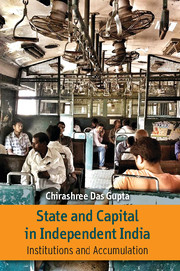Book contents
- Frontmatter
- Dedication
- Contents
- Figures
- Tables
- Acknowledgements
- 1 Introduction
- 2 Globalization and Neoliberalism: The Context and the Debate
- 3 State and Capital in Independent India: The Problematic
- 4 Policy Regimes and Macroeconomic Outcomes: 1947–1966
- 5 Institutionalization of the Regime of Capital in India: 1947–1966
- 6 Continuity and Change in Capital Accumulation: 1966–1980
- 7 Sources of Accumulation: State Intervention and Non-intervention
- 8 ‘Old Oligopolies and New Entrants’ in the Pharmaceutical Sector
- 9 Conclusion
- Bibliography
- Index
9 - Conclusion
Published online by Cambridge University Press: 05 September 2016
- Frontmatter
- Dedication
- Contents
- Figures
- Tables
- Acknowledgements
- 1 Introduction
- 2 Globalization and Neoliberalism: The Context and the Debate
- 3 State and Capital in Independent India: The Problematic
- 4 Policy Regimes and Macroeconomic Outcomes: 1947–1966
- 5 Institutionalization of the Regime of Capital in India: 1947–1966
- 6 Continuity and Change in Capital Accumulation: 1966–1980
- 7 Sources of Accumulation: State Intervention and Non-intervention
- 8 ‘Old Oligopolies and New Entrants’ in the Pharmaceutical Sector
- 9 Conclusion
- Bibliography
- Index
Summary
The growth of capitalist accumulation in India has always to a large extent depended on the historical specificity of its relationship with the state. The development of capitalist enclaves in the late colonial period when the political power of the tiny Indian capitalist class was linked to the crisis of the British empire in the inter-war years due to the competition faced by British capital from other rising imperial powers. However, big capitalists soon achieved much greater influence over the structure and parameters of ‘development’ and capital accumulation in the state-to-be through their strong representation in the National Planning Committee in the years prior to independence. This change in the political power of capitalists had to do with political developments within the mainstream of the national liberation struggle, the marginalization of the Left within the Congress between the Haripura to Tripuri sessions (1938 and 1939) and Congress taking office in the Provincial Governments in 1937. After independence, the majority of FICCI members representing ‘big’ Indian capitalists were in favour of regulated capitalist development as had been agreed in the National Planning Committee report so long as the parameters of the planned economy were defined in consultation with capitalists.
Our survey of the relationship between the state and capital in independent India establishes eight important features of post-independence economic transition. First, the institutional basis of capital accumulation in India was laid in the first decade after independence. This was based on two institutions. First, the property rights and taxation structure were developed, which spanned corporate governance, taxation and personal laws. The second was the labour regime that was established through the narrow definition of ‘work’ and hence worker. Both of these institutions together legitimized the hierarchy of social relations based on caste and gender that formed the class basis of the predominantly mercantile capital accumulation regime in India. Moreover, the property rights and taxation structure privileged Hindus over Muslims, Christians, Jews and Parsis. This structure has shown resolute structural continuity across all policy regimes and is one of the key reasons for the continuity of the main contradiction of the Indian transition – the employment neutrality of all accumulation strategy and the widening scope of upward mobility only amongst the top two deciles of the population.
- Type
- Chapter
- Information
- State and Capital in Independent IndiaInstitutions and Accumulations, pp. 257 - 262Publisher: Cambridge University PressPrint publication year: 2016



